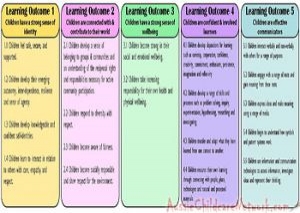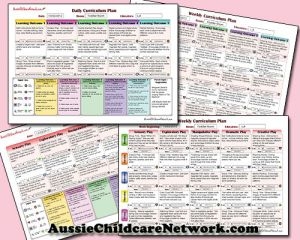

A Curiosity Approach environment fosters exploration, creativity, and sensory-rich experiences, making learning feel natural and engaging. Here are some additional ideas to enhance your nursery room setup.
Loose parts are open-ended materials that children can move, manipulate, stack, and combine in countless ways during play. They can be natural, recycled, or everyday items and encourage children to develop fine motor skills, critical thinking, and social interaction. The following article provides a list of Loose Parts Materials for Babies, Toddlers, and Preschoolers, Loose Parts Materials Based On Themes, How To Set Up Loose Parts Materials and more.
Supporting schemas through meaningful and engaging experiences helps nurture children’s natural learning processes. The following article provides activity ideas for incorporating schema-focused activities into the learning environment.
Setting up room displays can be quite exciting. The following article provides information on Non Negotiable Displays, Highly Recommended Displays, Optional Displays, Displays To Meets NQS In Australia, Displays To Meet National Regulations, Quality Ratings Display, Ideas For Creating A Children's Art Display, Examples Of Cultural Displays, Examples Of Aboriginal and Torres Strait Islander Displays, Themed Displays, Creating A Parent Displays and more.
Working barefoot is beneficial for educators in early childhood settings. It is comfortable and relaxing, which can contribute to a positive and calm atmosphere. The following article provides information on Benefits for Educators, Strategies For Educators, Implementing Barefoot Policies, Tips for Implementing Barefoot Practices for Educators, and more.
Inquiry-based learning in early childhood is a powerful approach that nurtures children's natural curiosity and encourages them to explore, ask questions, and discover answers through hands-on experiences. The following article provides information on the Benefits Of Implementing Inquiry Based Learning, Steps to Implement Inquiry-Based Learning, Guide Children In Inquiry Based Learning and more.
Lighting plays a crucial role in early childhood environments, impacting everything from mood and behavior to learning and development. The following article provides information on Effect Of Lighting, Effects Of Poor Lighting, The Effects Of Poor Lighting On Children, Dim Lighting In Early Childhood and more.
Meditation can be a wonderful tool for preschoolers to help them relax, focus, and manage their emotions. The following article provides simple and engaging meditation activities for young children.
Kinaesthetic learners, also known as tactile learners, thrive on physical movement and hands-on experiences. They learn best through activities that involve touch, movement, and manipulation of objects. The following information provides information on How To Identify Kinaesthetic Learners, Characteristics of Kinaesthetic Learners, Strategies to Support Kinaesthetic Learners and more.
Involving children in documentation in early childhood education can be a powerful way to engage them in their own learning process. The following article provides information on Strategies Involving Children In Documentation and Multimodal Representations.
 Here is the list of the EYLF Learning Outcomes that you can use as a guide or reference for your documentation and planning. The EYLF… Read More
Here is the list of the EYLF Learning Outcomes that you can use as a guide or reference for your documentation and planning. The EYLF… Read More
 The EYLF is a guide which consists of Principles, Practices and 5 main Learning Outcomes along with each of their sub outcomes, based on identity,… Read More
The EYLF is a guide which consists of Principles, Practices and 5 main Learning Outcomes along with each of their sub outcomes, based on identity,… Read More
 This is a guide on How to Write a Learning Story. It provides information on What Is A Learning Story, Writing A Learning Story, Sample… Read More
This is a guide on How to Write a Learning Story. It provides information on What Is A Learning Story, Writing A Learning Story, Sample… Read More
 One of the most important types of documentation methods that educators needs to be familiar with are “observations”. Observations are crucial for all early childhood… Read More
One of the most important types of documentation methods that educators needs to be familiar with are “observations”. Observations are crucial for all early childhood… Read More
 To support children achieve learning outcomes from the EYLF Framework, the following list gives educators examples of how to promote children's learning in each individual… Read More
To support children achieve learning outcomes from the EYLF Framework, the following list gives educators examples of how to promote children's learning in each individual… Read More
 Reflective practice is learning from everyday situations and issues and concerns that arise which form part of our daily routine while working in an early… Read More
Reflective practice is learning from everyday situations and issues and concerns that arise which form part of our daily routine while working in an early… Read More
 Within Australia, Programming and Planning is reflected and supported by the Early Years Learning Framework. Educators within early childhood settings, use the EYLF to guide… Read More
Within Australia, Programming and Planning is reflected and supported by the Early Years Learning Framework. Educators within early childhood settings, use the EYLF to guide… Read More
 When observing children, it's important that we use a range of different observation methods from running records, learning stories to photographs and work samples. Using… Read More
When observing children, it's important that we use a range of different observation methods from running records, learning stories to photographs and work samples. Using… Read More
 This is a guide for educators on what to observe under each sub learning outcome from the EYLF Framework, when a child is engaged in… Read More
This is a guide for educators on what to observe under each sub learning outcome from the EYLF Framework, when a child is engaged in… Read More
 The Early Years Learning Framework describes the curriculum as “all the interactions, experiences, activities, routines and events, planned and unplanned, that occur in an environment… Read More
The Early Years Learning Framework describes the curriculum as “all the interactions, experiences, activities, routines and events, planned and unplanned, that occur in an environment… Read More

Within an early childhood setting, throughout the day, children experience many transitions such as transitions...
See more...
Celebrating Halloween in early childhood settings in Australia can be a fun and enriching experience...
See more...
Autism in young children, often referred to as Autism Spectrum Disorder (ASD), is a developmental...
See more...© 2009-2025 Aussie Childcare Network Pty Ltd. All Rights Reserved.
